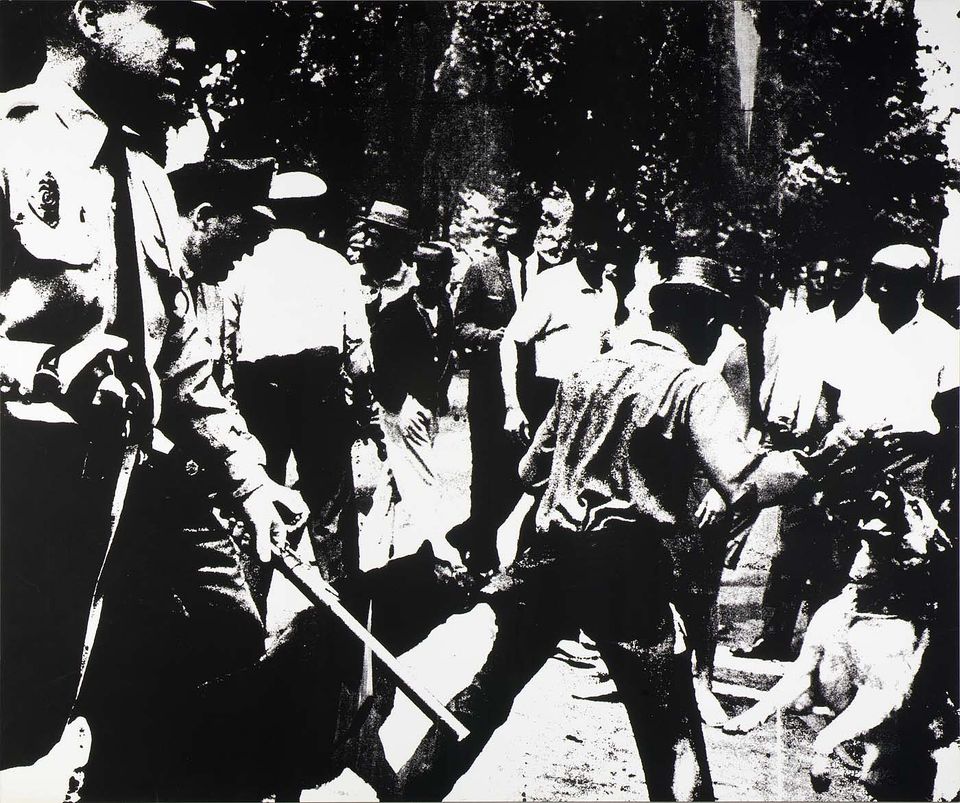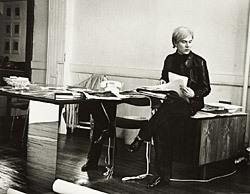
Andy Warhol (1928–1987), Untitled (Birmingham, Alabama), (from the portfolio Ten Works x Ten Painters), 1964, serigraph, 20 x 24 in., Smithsonian American Art Museum, Museum purchase, © 1964 Wadsworth Atheneum, 1965.37.2E
Student Questions
1. Who is the central character in this scene? How do we know to focus on him?
2. What is happening around him? What elements heighten the drama? Can you imagine what action could have led up to this moment?
3. Andy Warhol often used images from advertisements, newspapers, and other mass media. Do you think the artist changed this black-and-white image? If so, why might he have done that?
About This Artwork
The mainstream media hardly took notice in April 1963 when Martin Luther King Jr.'s Southern Christian Leadership Conference organized a series of demonstrations to challenge segregation in Birmingham, Alabama. But in May, after Public Safety Commissioner Eugene "Bull" Connor instructed the police to squelch the protests, photographers and TV crews descended to report on the violent results. Their now-iconic images of young men and women mauled by dogs and pinned down by high-pressure hoses brought the bitter realities of the African American freedom struggle into every American's home. As King recalled, such images had a powerful effect: "The brutality ... was caught—as a fugitive from a penitentiary is often caught—in gigantic circling spotlights. It was imprisoned in a luminous glare revealing the naked truth to the whole world."
Andy Warhol based this print on one of these news images—Charles Moore's photograph of a man attacked by police dogs—which appeared in Life magazine, a popular weekly known for its photojournalism. However, Warhol made significant alterations to the photograph: he reversed and enlarged the image, he cropped in on a specific section, and he increased the contrast. These changes produce striking effects. They not only center on the violence—dogs ripping at a man's trousers and snapping at his hand—but they use the other figures in the scene to frame the attack. The looming policeman on the left, nightstick at the ready, and a row of witnesses along the rear encircle the action, constricting the space. Viewers enter the scene, as if we are one of the spectators helplessly watching. Warhol's use of high contrast intensifies our emotional participation. He reduced the photograph's gray, middle tones, which erases many of its finer details. The grainy image sears the assault into memory.
In the early 1960s, Warhol began creating a number of prints like Untitled (Birmingham, Alabama) based on popular imagery: publicity shots of celebrities, comic book characters, consumer goods packaging, and photographs of disasters. By appropriating such images, altering them, and then displaying them in galleries as works of art, Warhol famously blurred the distinctions among art, commerce, and mass media. Although Warhol, with characteristic aloofness, often playfully raised the question, "What is art?", this print asserts its subject's gravity. Judging by this artwork, Warhol was becoming deeply concerned about race relations in the United States. Indeed, the printmaker Warhol hired to produce his image recalled that Warhol referred to the incident as a "blot on the American conscience," and then asked him to make later editions of the print "muddier" so as to convey his sentiment.
About This Artist
Andy Warhol (born Andrew Warhola, Pittsburgh, PA 1928–died New York City 1987)
Inspired by mass media, consumerism, and popular culture, Andy Warhol created artworks and a celebrity persona that had an enormous impact on contemporary art. Warhol majored in design at Carnegie Institute of Technology (now Carnegie Mellon University) in Pittsburgh. Thereafter, he moved to New York City, where he worked in the 1950s as a successful illustrator and display designer. In the 1960s, Warhol joined the emerging pop art movement when he created paintings based on ordinary consumer products, such as cans of Campbell’s Soup; of celebrities, notably Marilyn Monroe; and of disasters, which were based on newspaper photographs. He established The Factory, an art studio where assistants produced work for him using commercial silkscreen techniques. Warhol’s mass-produced art was controversial because it challenged widespread assumptions about art as a form of personal expression and about the value of originality. Warhol also produced films, made photographs and sculpture, and co-founded the celebrity magazine Interview. Throughout his wide-ranging career, Warhol recognized the power of the media, predicting in 1968 that in an increasingly media-saturated culture, “Everyone will be world famous for 15 minutes.”
Related Material

Jim Wallace, images from Chapel Hill, N.C., 1963 and 1964. © Jim Wallace, Collection of National Museum of African American History and Culture, Gift of James H Wallace Jr.
The increasing willingness of the mainstream media to print images of racial violence in the early 1960s was a turning point in the Civil Rights movement. Photographs like these, which document nonviolent protests and harsh reactions by local authorities, helped increase support among the general public. Although civil rights activists had long enlisted photography to shape public opinion about African Americans, they came to rely on these gripping images in their push for change.

Deck of cards made and used by Freedom Riders and pins, c. 1961, National Museum of American History, Behring Center
With Boynton v. Virginia in 1960, the Supreme Court reinforced and extended earlier decisions against racial segregation on interstate travel by protecting travelers from local ordinances. To test the ruling, mixed-race activists rode buses and trains into the South to challenge local segregation laws. Known as Freedom Rides, these trips provoked violent reactions from many in the South. Activists, mostly young students, were firebombed, beaten, and arrested. They were also bored from hours upon hours of sitting in buses and stations. This deck of cards, made from old envelopes, demonstrates the resourcefulness and creativity the movement demanded.
















